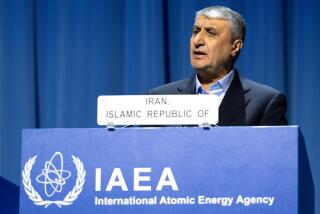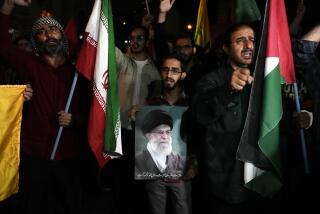Iran is seeing the biggest antigovernment protests in years. What’s driving the unrest?
- Share via
Reporting from TEHRAN — Since Dec. 28, Iranians nationwide have taken to the streets in a remarkable show of anger, demanding the resignations of the country’s top leaders.
Demonstrators in more than two dozen cities have confronted police and torn down pictures of Supreme Leader Ayatollah Ali Khamenei and President Hassan Rouhani — serious acts of defiance in a theocracy that imposes strict limits on speech.
Hundreds have been arrested and at least 20 killed, according to state media.
Iran has not seen protests this big since 2009, when authorities crushed a popular uprising that followed a disputed presidential election. Rouhani has acknowledged the frustrations, saying, “Criticism and protest are the people’s rights, and they should lead to solutions to the country’s problems.”
How did the protests start?
Frustration has been simmering for years over high unemployment and rising prices. Rouhani promised the economy would improve after the 2015 nuclear agreement that eased tough international sanctions, but many Iranians say they haven’t reaped the benefits.
In recent weeks, scattered protests broke out over unpaid wages and bank defaults in which ordinary investors lost their deposits. At a rally Dec. 28 in Mashhad, Iran’s second largest city, protesters railed against Rouhani’s handling of the economy.
But the demonstrators quickly turned against the hard-liners, led by Khamenei, whom many blame for blocking economic reforms while tolerating corruption and funding Shiite Muslim militias abroad.
Protests have taken place in more than 25 cities, including Tehran, the capital, and the holy city of Qom, home to one of the most important shrines in Shiite Islam and long thought to be a bulwark of the ruling mullahs.
Who are the demonstrators?
Unlike the 2009 postelection protests, which were led by Tehran’s educated middle class, these demonstrations appear to be driven by a more diverse group, including the young and working-class who have been hit especially hard by the economic malaise.
Women are among the demonstrators, including some who removed their headscarves in protest of the theocracy’s dress code.
Asieh Nezam Shahidi, a writer in Mashhad whose son was briefly detained by security forces, wrote on Facebook: “The poor, jobless and underpaid workers, the lower middle class and women without headscarves were the main corps of [protests] today, yesterday and the day before yesterday.”
Who’s leading the rallies?
Perhaps most astonishing about these protests is that there is no apparent leader or movement behind them.
The hard-liners who instigated the initial rallies have seen them spiral out of their control, and veterans of the 2009 Green Movement uprising are largely sitting on the sidelines, unsure where the unrest is headed.
“This is neither a revolution nor a political movement, but rather an explosion of the Iranian people’s pent-up frustrations over economic and political stagnation,” said Ali Vaez, Iran project director for the International Crisis Group.
The uprising has been hard to categorize, with some demanding the release of political prisoners while others call for the return of the monarchy that ruled Iran before the 1979 Islamic Revolution.
“Given its lack of leadership, organization and mission, it is likely to wane or will be repressed,” Vaez said. “The government so far has hoped for the former, but the longer the protests go on, the latter becomes likelier.
How is the government responding?
Khamenei broke his silence on the protests Tuesday, blaming foreign enemies for a conspiracy “to create problems for the Islamic establishment,” according to a report in state media.
Iran’s interior minister warned of a crackdown and said anyone who creates unrest “should pay the price.” Anti-riot police and volunteer Basij militiamen have deployed across Tehran, firing water cannons to disperse protesters from at least one busy public square butso far refraining from using heavy force.
The government has limited access to Instagram and the highly popular messaging app Telegram, one of the primary means for protesters to communicate.
What has the U.S. said?
President Trump, who has accused Iran of sponsoring terrorism and threatened to tear up the nuclear agreement, has tweeted several times in support of the protests, saying Sunday that Iran’s people “are finally getting wise as to how their money and wealth is being stolen.”
But analysts say Trump’s words could backfire, given the intense antipathy with which he is viewed in Iran, one of six mainly Muslim countries whose citizens are included in his U.S. travel ban.
Others point out that the U.S. was quick to cheer on the so-called Arab Spring uprisings in 2011, only to watch anti-authoritarian movements in Egypt, Libya and Yemen devolve into chaos.
How are countries in the region reacting?
There has been little official reaction among Iran’s regional rivals, presumably because Arab leaders understand that statements like Trump’s would be used by the Iranian leadership as evidence that unrest is being inspired from abroad.
But the demonstrations have received widespread coverage, especially in Saudi Arabia, which is engaged in deadly proxy wars with Iran in Syria and Yemen.
In an analysis published on the website of Saudi-owned Al Arabiya, the satellite network’s former general manager, Abdulrahman Rashed, focused on the cost of Iran’s regional military operations.
“Ali Khamenei, alongside his military and political leadership, believed that promoting their victories in Iraq, Syria and Lebanon would gain them popularity, therefore extending their existence,” he wrote. “But the tables have turned.”
Others cautioned against predicting a “Persian Spring” given the questions surrounding the uprising.
“I don’t think we know where it’s going, and it’s important not to try and inject expectations around the protests from the outside,” said Esfandyar Batmanghelidj, an analyst and founder of Bourse & Bazaar, a publication which tracks Iran’s post-sanctions economy. “It’s up to the protesters to decide what their aims are.”
Special correspondent Mostaghim reported from Tehran and Times staff writer Bengali from Mumbai, India. Times staff writer Alexandra Zavis in Beirut and special correspondent Omar Medhat in Cairo contributed to this report.
Follow @SBengali on Twitter
Two killed in three days of stunning protests in Iran: What our correspondent saw there
‘Kidney for sale’: Iran has a legal market for the organs, but the system doesn’t always work
What’s wrong with the Iranian army? Deadly shootings put spotlight on forced military service
UPDATES:
Jan. 2, 9:20 a.m.: This story was updated with the latest developments in the ongoing protests.
This story was originally published on Dec. 31.
More to Read
Sign up for Essential California
The most important California stories and recommendations in your inbox every morning.
You may occasionally receive promotional content from the Los Angeles Times.











